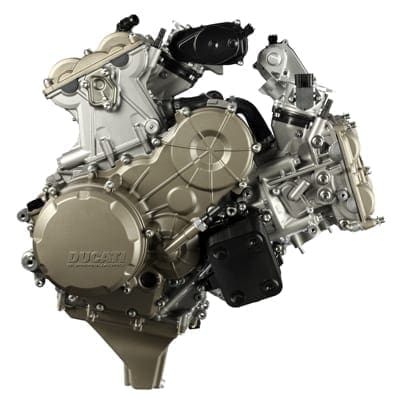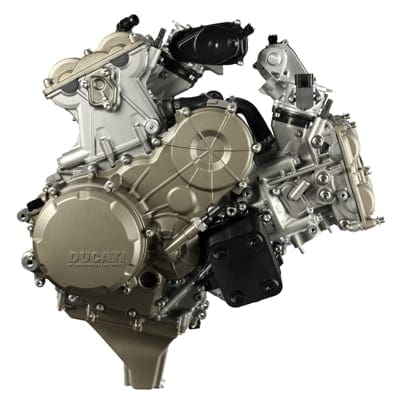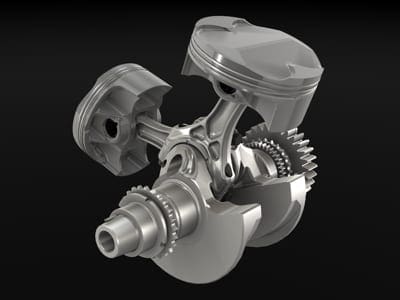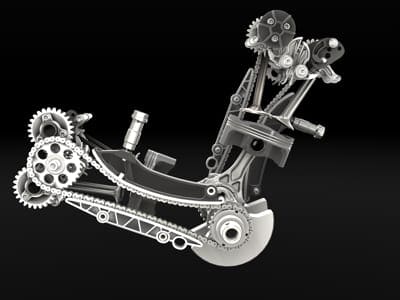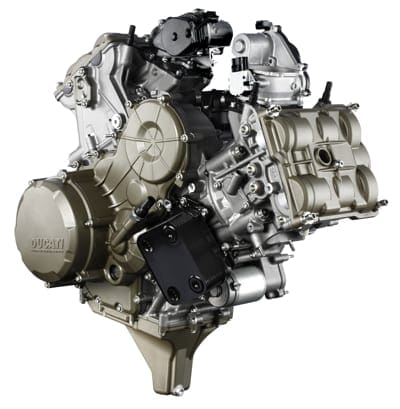Ducati has released details and images of the motor that will power its new 1199 Panigale superbike. Called the Superquadro, it’s claimed to be a no-compromise design – and who are we to argue? The design brief was easy – more power, more torque and more user friendliness. Add to that less weight and reduced maintenance costs and Bob’s your Aunty’s live in lover.
It’s called the Superquadro as it uses a massively over-square bore, and Ducati claim that this is good for an amazing 195bhp and 98.1 lb-ft of torque. Weight is down, electronic Riding Modes ensure ridability and major service intervals are extended to 24,000km. Architecture-wise, the 90-degree V (or rather L angle) is retained, as is the Desmodromic valve system.
Enjoy more Fast Bikes reading in the monthly magazine.
Click here to subscribe & save.
The motor is a fully stressed member of the chassis, but has been rotated backwards around the crankcases by six-degrees. This enables the motor to be shifted 32mm forwards to improve weight distribution. Crankcases are vacuum die-cast using weight saving Vacural technology – as we’ve seen in other members of the Ducati family. Primary drive, clutch, sump and cam covers are all made from lightweight Magnesium alloy. The crankcases use shell main bearings in the crank, technology borrowed from the Desmosedici RR. This removes the roller bearing system and enables larger crank journals to be used – increasing strength in this area.
The bore and stroke figures are 112 x 60.8mm. Peak power is at 10,750rpm, with peak torque reached at 9,000rpm. The bore and stroke rtio allows the motor to be revved higher and increases the cylinder head area, to allow bigger valves. Inlet valves have been increased from 43.5 to 46.8mm and exhaust valves change from 34.5 to 38.2mm. This is significant stuff. Because the valves are bigger, inertial forces are controlled by using lightweight titanium over steel. Previously only R models used these valves. Racing-derived rocker arms are now employed, with a polymeric-like carbon coating. Pistons have a double-ribbed undercrown to improve strength and reduce friction on the piston wall. Throttle body sizes are increased to take advantage of the new top end. They now stand at 67.5mm, from 63.9mm and remain fly-by-wire using twin injectors. A secondary air system completes the oxidisation of unburned fuel to reduce emissions. New, stronger gears have been designed, engaged by a wet clutch – closely modelled on the Multistrada and Diavel clutches. A slipper function is also used.
So that’s the news on the motor. We’ve yet to hear about what’s going on with the chassis, but expect to learn lots at the EICMA show in Milan from the 10th November. Head here from more details.
 Enjoy more Fast Bikes reading in the monthly magazine. Click here to subscribe.
Enjoy more Fast Bikes reading in the monthly magazine. Click here to subscribe.

